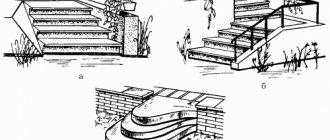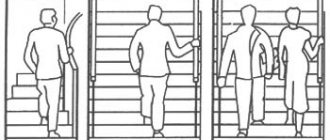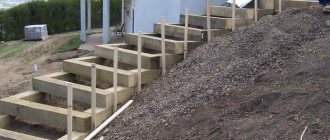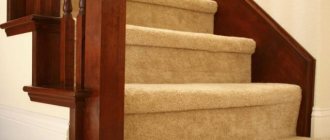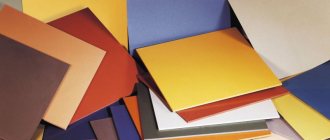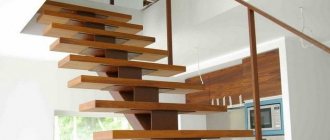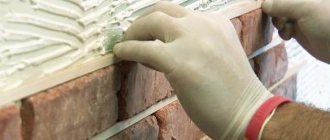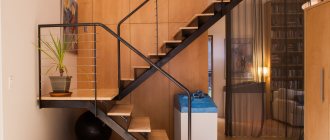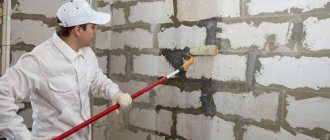Staircase projects always include a specification that specifies what material to use for finishing. Steps for stairs made of porcelain stoneware are the most durable and durable option. There are various options for this material that can be used in finishing. Porcelain tiles have high technical performance and ideally meet the requirements for abrasion and strength. A mandatory requirement for the internal stairs of a house is an aesthetically attractive appearance; in other words, designers need to create a beautiful interior using porcelain stoneware steps.
Beautiful porcelain stoneware solutions also imply high durability
Porcelain tiles, its advantages and disadvantages
Porcelain stoneware is a material for construction and finishing work, made from natural ingredients based on kaolin clay. In essence, it is a monolith pressed under high pressure, formed through the sintering process of sand, quartz, mineral paints and clay.
Thanks to modern production technologies, porcelain stoneware has the same properties as granite. If necessary, at the beginning of the production process, various fillers can be added to porcelain stoneware, which will subsequently give it the appearance of real stone or granite and make it an excellent decorative element.
Due to its composition, porcelain stoneware has a huge number of positive qualities:
- resistance to severe mechanical loads;
- wear resistance;
- high level of resistance to temperature changes and external atmospheric phenomena: snow, rain, hail, frost, heat;
- chemical resistance;
- fire safety;
- does not conduct electric current;
- easy to maintain;
- does not pose a danger to people and the environment;
- does not deform or change color during operation.
Thanks to these qualities, customers more often choose steps made of porcelain stoneware than concrete, wood or iron. The only drawback of porcelain stoneware is the cold surface. Many people consider it inappropriate to use it for interior decoration precisely because of this.
Video “We tile the steps of the stairs ourselves”
The recording shows the sequence of work when tiling the steps of a staircase.
The best posts
- Calculation of floor tiles for balconies and loggias
- Knitting a short women's jacket with a detachable collar from sectional yarn
- Decorating the hallway with decorative stone: simple, beautiful and modern
- How to join drywall in corners and the process of building a decorative niche
- 50 DIY gift ideas for February 23 (35 photos)
- Rubber tile laying technology
- Original DIY hanging shelf for wine and glasses
- How to build a reliable house from boards?
Related article: Installation of an apron in the kitchen made of MDF
Porcelain stoneware steps and their features
There are two types of porcelain stoneware steps: suture and solid. Suture types are available in thicknesses starting from 10 millimeters. Their leading edges are rolled and have a raised, round and semicircular appearance.
The one-piece type has a thickness of 12 millimeters and is produced in standard sheets of 1200x300 millimeters. This type is more expensive than suture. But working with solid steps is much more convenient and the steps after finishing have a more aesthetic and presentable appearance.
Based on their dimensions and content, porcelain stoneware steps are divided into corner, front and base. Thanks to its properties, porcelain stoneware offers enormous possibilities in choosing colors. The invoice may vary depending on the customer's preferences. You can imitate the type of stone: slate, basalt, marble or another. You can make it look like wood, parquet boards, or a design sample in the form of shell rock, sea pebbles, or volcanic lava.
Requirements and classification
Porcelain stoneware steps must meet the requirements of building regulations:
- The flight of stairs must be safe to use and have steps measuring 15-20 cm in height and 25-30 cm in width.
- The steps must be equipped with a special anti-slip strip. This is extremely necessary on stairs that are located on the outside of the premises and are exposed to atmospheric phenomena: ice, snow, rain.
- Steps along with the staircase should be part of the design of the room, and not a separate part of it.
Advice! To prevent injuries, it is recommended to use steps with an unpolished or textured surface. This will minimize the possibility of slipping and you can use the flight of stairs safely.
Based on the processing methods, the stages are divided into:
- Sanded or matte. They are subjected to rough grinding and minor polishing. They have a high degree of friction and do not slip in cold weather or rain. These steps are used to equip the entrance to the premises from the street.
- Glazed. Although they have a mirror finish, they also have excellent anti-slip properties. Thanks to these characteristics, they are installed both indoors and at the entrance from the street.
- Polished. These steps have a mirror surface. They are used for interior finishing work and porch covering. It is advisable to provide an anti-slip pad.
- Unpolished. They have a weak mirror surface. Used for finishing work on steps at the entrance from the street.
Features of porcelain stoneware
Wood finishing of metal, reinforced concrete and wooden structures
Metal structures are processed in two ways. The first is the so-called partial option: wooden treads are attached to the metal steps, and the remaining parts remain as before. The second option is full cladding, that is, covering all parts of the structure. In this case, as a result of the work, you can get a structure that is practically no different from a wooden one, but only with a reliable metal frame. This option is more common than partial.
Stairs made of reinforced concrete are considered the most reliable. Concrete is not subject to deformation after prolonged exposure to moisture.
Most often, finishing of wooden structures occurs with the help of varnishes and paints. However, varnishing is a more economical and high-quality method.
If you need wood cladding for stairs at a price that will pleasantly surprise you, then contact us!
Stage configuration
A set of porcelain stoneware steps consists of the following parts: plinth, riser and tread. A monolithic step has a tread combined with a riser. Each part has its own details. Tread is a tile on which cuts and stripes are applied, designed to provide better grip on shoes and reduce slipping. The strips can be made from abrasives. For greater safety, additional small grooves are equipped on the surfaces of the steps. They are applied during the manufacture of slabs. When water gets on the tiles, it will drain, which will reduce slipping in rainy weather and in winter. A riser is a wall that is installed vertically between the treads. Its main characteristic is height. By combining risers and treads of various shades you can create a beautiful flight of stairs. The plinth is the corner part of the steps. Used to give an aesthetic appearance to corner joints.
Porcelain tiles: impressive and affordable
Buyers choose porcelain stoneware when the aesthetic qualities of the material are important. Decorative stairs are very impressive. Porcelain tiles are inexpensive and easy to install, but become dangerous in low temperatures and during the rainy season. The surface of the tile does not absorb water - this is good, it is frost-resistant. But the coating turns out completely smooth. Light condensation or drizzle is enough for the surface of the steps to turn into a skating rink. As a result, the owners of such stairs have to spoil the beauty of porcelain stoneware and screw anti-slip strips onto the stairs.
Facing the porch is an important stage in home improvement. Make a choice in favor of practicality and safety.
Technology of facing steps with porcelain stoneware
Monolithic steps are ideal for cladding. To ensure a good fit of the parts of the steps, a water-cutting machine is used . When working with it, chips and cracks do not form on the tiles. When starting work, it is necessary to prepare the following steps:
- Using a roller, you need to open the steps with acrylic primer. This will provide an improved connection between the staircase base and the tiles. Level uneven surfaces with putty and cover again with acrylic primer.
- Check that the dimensions of the ceramic slabs and steps match. The excess size of the tile must be trimmed. Cutting the tiles after gluing is not recommended.
The process of cutting porcelain tiles
The procedure for installing ceramic tiles:
- The tiles are laid using an adhesive solution for porcelain tiles. Laying is done from top to bottom. This creates convenience for applying mortar and laying tiles;
- The prepared adhesive solution is applied with a spatula to the surface of the steps and the treads are laid. The entire space must be free of voids and filled with adhesive solution;
- after laying the treads, the riser is laid in the same way;
- Corners are installed in corner joints;
- After laying, the seams are treated with grout material and cleaned.
Laying steps made of porcelain stoneware
Edge finishing options
When using tiles for stairs, special attention should be paid to finishing the edges of the steps, in particular the ends. To prevent the destruction of the finish in the most vulnerable places and give it a neat look, you can use the following tile options for stairs:
- Angular _ This is the best option for edge protection. Such elements have the form of a corner, that is, they consist of perpendicularly located fragments connected to each other. They allow you to create a perfectly even angle on the steps.
- Embossed . This is a way to prevent the surface from slipping. Special elements with relief are placed along the edge. Mostly such models are found among clinker coatings.
- End pads . As an alternative to the materials described above for staircase structures, overlays on the edge of the tread or external corners are used. They are made of metal or polyurethane. They can be attached to self-tapping screws or liquid nails. They provide both chip and slip protection.
- Overhang installation . The simplest option for cladding stairs in a house is to install edge tiles with a small overhang, no more than 5-7 mm. You can only use tiles with a thick glazed edge.
Options for finishing the edges of steps when tiling
High-quality installation of cladding on the steps will give the staircase a luxurious look. Take extra care to finish the seams between the tiles. With proper care, the coating will last for decades.
Caring for porcelain tiles
Although porcelain stoneware is resistant to external influences, it also requires proper care. It is characteristic that, first of all, it is not the porcelain tiles that are exposed, but the connecting seams. They are less stable than tiles. Therefore, if pollutants get on porcelain tiles, you should not hesitate to clean them. Surface washing of porcelain stoneware tiles during everyday cleaning can be done with a simple soap solution. There is no need to use detergents that have an acid base, as this can ruin the color of the seams. During maintenance, it is worth excluding abrasive materials, the use of which leads to damage to the polished surfaces of porcelain stoneware.
When performing repairs, it is necessary to take measures to protect porcelain tiles from mechanical damage. A screwdriver or hammer that falls out of your hands, even if it doesn’t break the tile, can break off a piece from it or leave a crack. There are some recommendations for caring for porcelain tiles in case of various stains:
- Juice, cola, ice cream, coffee, tea, fat, wine, blood - use a solution of water and soda. If the stains are dry, use substances that contain alkali: sodium or chlorine.
- Traces of varnish, paint, resins, wax, glue, “chewing gum” - use solvents, for example: trichloroethane, gasoline or acetone.
- Lime, cement or rust stains, putty, traces of nicotine - are removed with acid-containing detergents. They must be used with caution, because seams are very susceptible to acid.
Design solutions
Uniqueness is a task that arises when performing any design work. Designers make excellent use of the shapes and colors of porcelain stoneware, tastefully decorating rooms. Porcelain stoneware steps look elegant and majestic. This can be supplemented with LED lighting, forged railings and other elements.
There are quite a lot of styling options. You can make any pattern from porcelain stoneware. Monolithic steps are especially suitable for this. There are special collection sets for this. Porcelain tiles can make street and home stairs a bright part of the interior/exterior. Choosing porcelain tiles